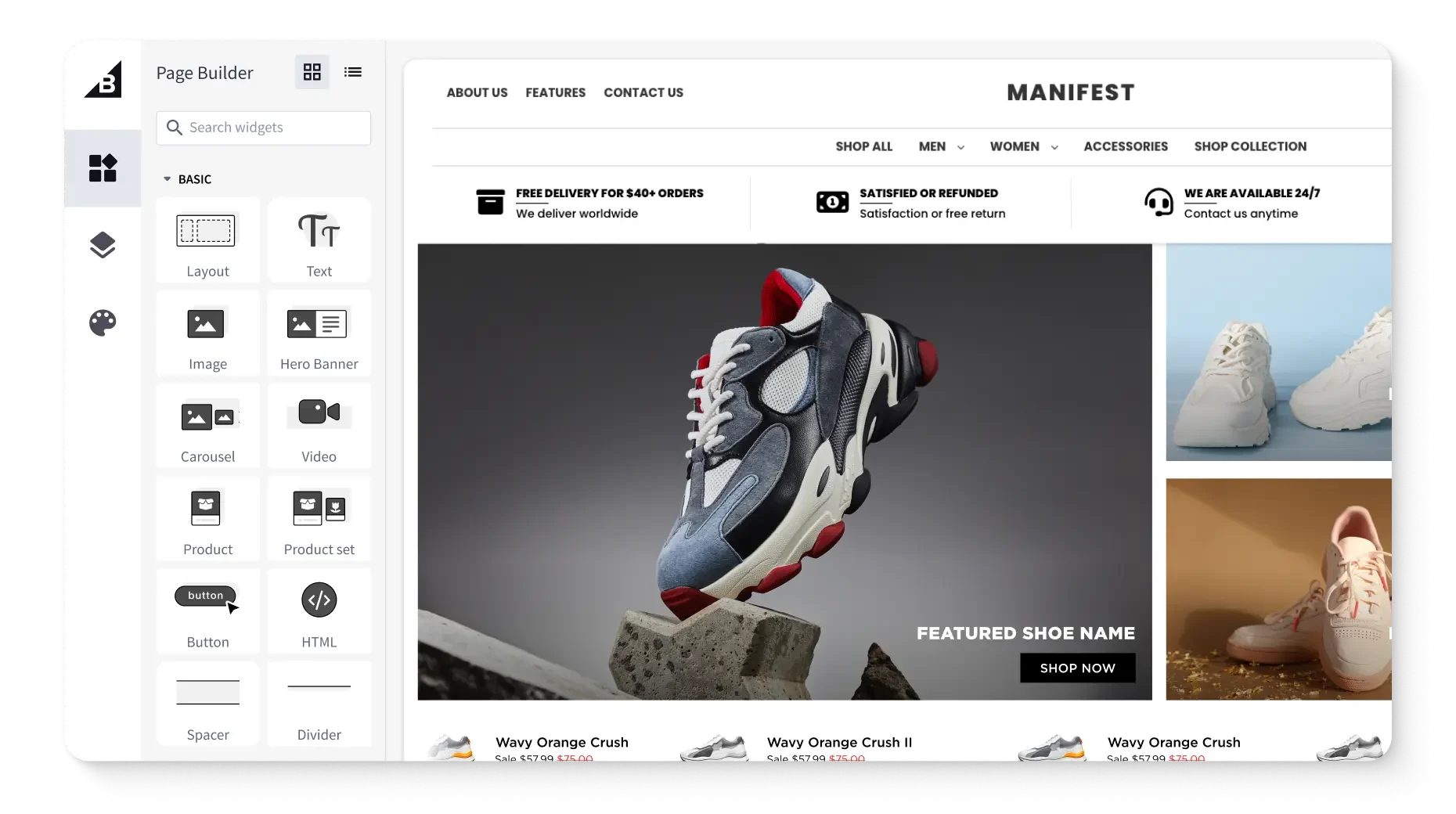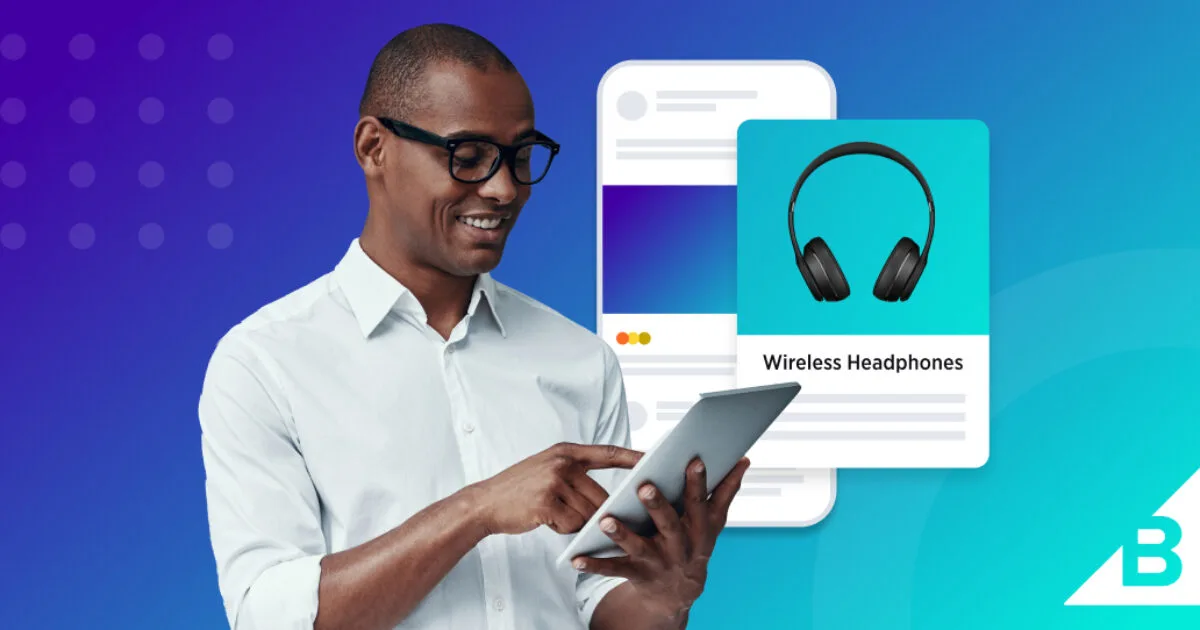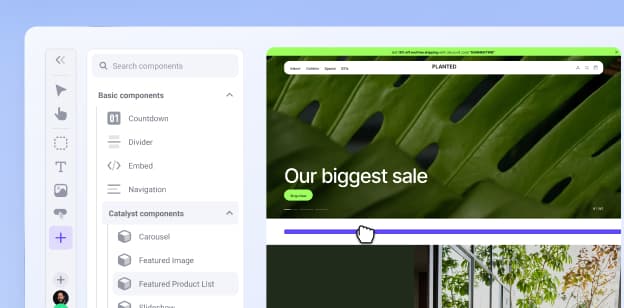Navigating Social Media Advertising: How to Choose the Right Platform and Ads for Your Brand

Written by
BigCommerce Team17/11/2025


Zero transaction fees? Say no more.
We never charge additional transaction fees for any payment provider. Guaranteed.
Key Highlights:
Three ways to run a social media ad campaign (and the pros and cons).
How to build your social media ad strategy, including audience research and targeting options.
How to choose the best platforms to advertise on, and the kinds of ad formats they offer.
How to promote your ads and why optimisation matters.
Why measuring the performance of your campaign just by likes and shares isn’t enough to tell you what’s working.
It’s tough to get your content noticed these days.
Social media algorithms and search rankings are constantly changing. Organic reach is great, but going viral is rare. So how do you get noticed?
Paid social advertising is essential. These targeted ads put your content in front of the right audience.
About 75% of Gen Z and nearly half of millennials say social media ads influence their buying decisions. And they’re only some of the billions of social media users.
Whether you’re growing a small business or running a well-known brand, the benefits of social media advertising are clear. It helps you reach more customers, build awareness, and turn engagement into results.
Here’s how to find the best social media marketing strategy for your brand.

Get a free 15-day trial of BigCommerce.
No credit cards. No commitment. Explore at your own pace.
How to manage your social media advertising campaigns
There are three ways to manage a campaign.
Run your ad campaigns manually.
This is the most affordable and straightforward option.
Pros
Running your own ad campaign means you can spend your entire budget on testing ads to find what works best. You can also:
Avoid extra costs for ad management tools or agency fees.
Gain valuable experience to help improve future campaigns.
Cons
Becoming an ad guru takes time and commitment. The more time you invest in advertising, the less you can spend in other areas of your business. And even with all that time spent, you might not get the results you want.
Who is it ideal for?
Businesses on a tight budget. Staff willing to invest the time to learn the ropes.
Run your ad campaigns using automated software.
There are plenty of third-party tools — like AdEspresso or Revealbot — to help you manage your social media campaigns. You wouldn’t be alone. Spending on these tools in the United States is expected to reach more than $122 billion by 2026,
Pros
Third-party tools like this can help you optimise Facebook ad campaigns and analyse results. They’re much more effective than Facebook’s Ad Manager. And tools like Adext use AI to manage entire campaigns.
Cons
Cost.
What’s more, you might not get the results you want. And it might be more challenging to identify where the ad manager isn’t delivering.
Who is it ideal for?
Businesses on a tight budget with little time to run their own campaigns.
Third-party tools can help you create a successful campaign without the time investment.
Hire a professional to run your ad campaigns.
It’s the most expensive option, but hiring a professional is the best choice for achieving results.
Pros
Social media ad professionals know what they’re doing. They do the work so you can focus on other areas of your business.
If your ads aren’t performing, you can hire a new agency.
Cons
High average cost, especially if you hire a sub-par agency. Make sure of your agencies before hiring.
Who is it ideal for?
Companies with money to spend and a desire for immediate results.
How to build a creative social media advertising strategy
Determine what to sell.
Skip this step if you only sell one product.
If your business has a large product catalogue, identify which to feature in your advertising efforts.
Determine which products generate high profits but aren’t performing well. Alternatively, featuring a bestseller is a great bet for more conversions and sales.
Research your audience.
Understand who they are and what they want.
To gain more insight into your audience, consider:
Customer reviews — whether from your online store, blogs, YouTube videos, or Reddit posts.
Google Trends and keyword searches can help you understand how customers think about your products or topics.
Search for related hashtags on your brand’s social networks. That could also help you learn how to boost organic search for your products.
Use a creative platform.
Social platforms like Facebook, Instagram, Snapchat, and X offer ways for businesses to get creative with their customer interactions.
Harness the best these platforms have to offer for your brand to boost engagement. Then keep a consistent presence.
Create a digital marketing campaign.
Once you know your product and audience, it’s time to plan your campaign. Here are four steps to building a successful social media marketing campaign:
Define your goals.
Maybe it’s brand awareness, more social media followers, or a higher SEO ranking. Make sure you have a clear goal to inform your campaign planning.
Identify your target audience.
Know who your customers are and what they want and need. What problems do your products solve for them?
Create customer personas.
This is a detailed description of your target customer. It highlights demographics and other details that influence what they buy.
Determine your budget.
Decide how much to invest for the biggest bang for your buck. Luckily, social media marketing is usually more cost effective than traditional advertising.
Improve your performance.
You can use these tools to help measure and improve your campaign’s performance:
Return on advertising spend (ROAS) can help you understand how your ads are performing. The downside: it can’t tell you why.
The AIDA system can help you understand how customers experience your content. Designed in 1898, AIDA is a behavioural model that highlights the four effects an ad should have on a customer:
Attention: The content should grab them.
Interest: It should hold their attention.
Desire: It should make them want to explore more.
Action: It should deliver results, from conversions to purchases.
Manage your product feed across ad platforms.
Ensure your listings stay accurate, consistent, and optimised wherever they appear. By centralising updates — like pricing, availability, and descriptions — you save time and prevent errors.
Plus, a well-managed feed helps each platform’s algorithm better match your products to the right audience. And that boosts performance and ROI.
Best social media platforms to advertise on
To decide where to advertise, learn where your ideal customers hang out and meet them there.
Here are the most popular platforms and the kinds of ads they support:
Facebook.
As the largest social media platform in the world, Facebook is popular among a wide variety of demographics. That means there’s a good chance your target audience is engaging with the platform, too.
Here are a few Facebook advertising options to help you meet campaign goals:
Image and Video ads
Image ads and video ads are the most basic ad formats and the simplest to design. Highlight new products and services with a single high-quality image or video, for any point in the sales funnel.
Stories ads
Stories ads are full-screen image, video, or carousel ads on Facebook, Messenger, or Instagram that appear between user stories. They don’t disappear after 24 hours, meaning your content has a greater chance of inspiring awareness and conversion.
Carousel ads
Carousel ads allow advertisers to show two or more images or videos within a single ad. Each ad can have its own headline, description, link, or call to action (CTA). Use them to tell a story or feature multiple products.
Slideshow ads
Slideshow ads use up to 10 images or a single video, displayed in a slideshow. Unlike video ads, they load fast and they’re easy to create.
Collections ads
Collection ads make it easier for people to discover, browse, and seamlessly purchase products from their browsers or mobile devices. Each ad features a primary video or image and three images below in a grid layout. They create an immersive experience.
Messenger ads
Messenger ads appear in the Chats tab of the Messenger app. If a customer taps on the ad, they’ll be sent a detailed view of the product or service. It will include a CTA to go to a site or begin a conversation with an agent.
Playable ads
Playable ads give customers the opportunity to test drive your app–right in the ad–- before buying.
Instagram.
Instagram is a visual platform, ideal for brands with visually appealing products. It has a huge user base, the second-highest engagement rate among social media platforms, and one of the youngest audiences.
Instagram ads are a great option for brands with those demographics. Here are the options:
Image and Video ads
Photo and video ads are the most common. In between posts from friends and followers, these ads (displayed as posts, Stories, or Reels) point customers toward a company page or store.
Instant Experience ads
Instant Experience (IX) ads are an immersive full-screen format designed primarily for mobile devices. In IX, people can watch a video, swipe a carousel, see products in your catalogue, explore images with tagged products, and click buttons to visit web pages.
Collection ads
Like Facebook, collection ads help users uncover and buy products from their mobile devices. Each collection ad includes a cover video or image with smaller product images below.
Explore feed ads
Explore feed ads are on Instagram’s Explore page, where users go to discover new content, watch videos and shop. With these ads, businesses can meet receptive customers where they are.
Polling sticker ads
Polling ads are interactive Instagram stories designed to drive engagement. They allow users to answer questions with multiple choice answers and share their opinions.
Instagram Shopping ads
Instagram Shopping ads are great for direct-to-consumer commerce, personalising a buyer’s journey. Customers tap a product tag to learn more about an item and how to buy it. They can maximise the reach of your products and boost shoppable posts.
X.
As the go-to platform for breaking news and engaging with influencers, X has been one of the most popular social media channels since its launch in 2006.
X ads offers several different options for brands to advertise, including:
Image and video ads
Twitter image and video ads help you highlight your products and capture customers’ attention. Easy to create and use, these ads point people toward a site or inspire engagement.
Carousel ads
Carousel ads allow you to tell a story and drive users to your site or app. With up to six horizontally swipeable images or videos, you can showcase multiple products or promotions.
Moment ads
Moments ads are a collection of X posts that tell an immersive story beyond the normal character limits. They can provide different perspectives and promote unique stories.
Text ads
X text ads resemble a standard X post or Tweet, including likes, replies, favourites, and re-posts. These native ads are meant to feel like regular X content, allowing users to expand the reach of their business organically.
Follower ads
Follower ads target a particular audience, building awareness, and attracting new followers. They appear as promoted X posts in the target’s timeline and can lead to organic discovery.
X Amplify ads
X Amplify ads are pre-roll advertisements that appear before the premium content your customers are already watching, from highlights to viral clips. They help you capture an existing audience.
X Takeover ads
X Takeover ads place your brand at the top of the conversation as the first ad of the day. When your target audience refreshes their X timeline, your ad will be the first one they see.
TikTok.
TikTok is a powerful video platform, great for reaching younger audiences. In just a few years, the platform has grown in the US from 35.7 million users in 2019 to more than 94 million in 2022.
TikTok ad options are growing and include:
Image and Video ads
Despite being a video platform, TikTok supports both image and video ad formats. Brands can place both ad types via TikTok’s news feed apps or in between videos on a user’s feed.
In-Feed ads
In-Feed ads appear in a user’s For You Feed. They’re designed to capture attention and drive engagement.
Hashtag challenges ads
Branded Hashtag Challenge ads are meant to spark trends and cultural movements through viral challenges or hashtags. They’re great for building brand awareness.
Pinterest.
Pinterest is another highly visual platform where users pin content they like. It’s great for advertising because users typically use the platform to find and purchase products.
Pinterest ads use a highly targeted search engine, allowing brands to advertise via the following options:
Standard and Video Pin ads
Standard and Video Pin ads are the primary option for advertisers. Brands show high-quality content to capture attention and drive engagement.
Carousel Pin ads
Carousel Pin ads are a Standard Pin, but with multiple images. They’re best for showcasing the different features and capabilities of a product or advertising multiple products.
Idea Pin ads
Idea Pin ads are a multi-page spread to share ideas, show off the personality of the brand and drive people towards your store with unique content.
With more than a billion members, LinkedIn is the world’s largest professional network. LinkedIn advertising can target customers based on professional qualifications and works well for B2C and B2B campaigns.
There are several types of LinkedIn ads, including:
Single Image and Video ads
Single image and video ads allow brands to captivate a professional audience with native image or video content. They’re intended for every stage of the buyer’s journey, all displayed across the regular LinkedIn feed.
Carousel ads
Carousel ads allow brands to tell an interactive story through a swipeable series of cards, images, or videos in the LinkedIn feed. These ads are customisable, from the content to the landing page.
Event ads
Event Ads let you amplify LinkedIn events or webinars to drive maximum attendance.
Document ads
Document Ads allow businesses to share documents — like white papers or how-to guides — within the LinkedIn feed.
Conversation ads
Conversation Ads work by engaging prospects in InMail to drive professional conversations and promote products or services.
Message ads
Message Ads allow businesses to send direct messages to prospects to spark immediate action and begin conversations.
Lead Gen Form ads
Lead Generation Forms make it easy for brands to collect quality leads from ads on LinkedIn through pre-filled forms or documents.
Text ads
Text Ads can drive new customers to your business through items such as compelling headlines, short descriptions, or images.
Spotlight ads
Spotlight Ads showcase a brand’s products, services, or events to increase website traffic.
Follower ads
Follower Ads take advantage of existing connections to promote your LinkedIn page and acquire additional followers. They’re a great vehicle for a CTA.
Snapchat.
Snapchat is a messaging platform, popular primarily among millennials and Gen Zers. It has nearly 500 million users worldwide in 2025 and is a great opportunity for advertisers who want to tap into that demographic.
There are several different Snapchat ad types, including:
Single Image and Video ads
Single Image and Video Ads are full screen ads that are easy to create and can be used for all business objectives, from awareness to purchase.
Collection ads
Collection Ads showcase a series of products on four tappable tiles, giving users a seamless way to browse and buy.
Story ads
Story Ads make it simple to reach users with a series of three to twenty image or video ads, either through the content page or a branded tile in the Discover section.
Lenses AR ads
Lenses AR Experience ads create interactive moments with augmented experiences. Users can engage with the content and send it to friends.
Commercials ads
Commercials are non-skippable ads that appear for six seconds to three minutes. They’re part of Snapchat’s curated content, encouraging audiences to engage and driving brand awareness.
Filter ads.
Filter ads allow brands to participate in Snapchat users’ conversations as they visit neighbourhoods, parks, shops, or restaurants, or on particular holidays.
Promoting your social media ads
Once you’ve chosen your social media platforms and the types of ads you want to display, it’s time to boost those ads.
Try these strategies to get more eyes on your content and turn viewers into customers:
Audience targeting.
Targeting an audience means focusing on a particular demographic, whether it’s age, gender, occupation, or interest. You can target audiences by:
Using keyword searches.
Surveying or interviewing customers.
Creating clear customer personas.
Targeting new and potential customers.
Retargeting existing customers to remind them of your brand.
Promote and reuse organic content.
Extend the life of that great organic content by repurposing it and promoting it through ad campaigns.
Paid search and social ads.
Using re-marketing lists for search ads (RLSA), you can tailor your pay-per-click (PPC) search ads based on whether a customer has visited your online store and which pages they viewed. That helps retain customers who are already familiar with your brand.
Now, take it up a notch by combining paid ads with paid search and social ads to target both those who know and don’t know your brand. Social ads build brand awareness among customers who don’t know your products. When they see your PPC ads, they should feel more comfortable clicking.
Improve quality score.
A quality score is a metric search engines use to rank the quality of your keywords and PPC ads. The higher your score, the higher your ad will rank, and the more impressions it will get at a lower cost per engagement.
By posting organically to social advertising platforms and tracking engagement with each ad, you can compare to find out which paid social media ads are performing well.
Optimise user engagement.
Search engines are looking at your CTR, bounce rate, and conversion rate. Even if user engagement isn’t a core ranking factor for search engines, high CTRs and conversion rates will still result in better organic search rankings and more conversions.
To optimise user engagement and get to those conversions, you need to optimise your ad content. You can do that by using keywords, boosting page loading speed, and ensuring mobile-friendliness.
Make sure ads are mobile-friendly.
Because most Facebook users access the app via a mobile device, your ads must be mobile-friendly.
That means more than just fitting on a small screen. It means they must be designed with a mobile user in mind. Go for legible branding, clear text, eye-catching graphics, and interactivity whenever possible.
The final word
With all the social media platform options and great content out there, plus constantly evolving search engine algorithms, getting your content noticed can be tough.
Social media advertising is one of the most effective ways to raise brand awareness and engage customers where they are. Getting started can be daunting, but this is a great roadmap to start your journey. You’ll be on your way to more consideration and conversion in no time.
FAQs about social media advertising
Track key performance indicators (KPIs) such as:
Return on ad spend (ROAS)
Cost per click (CPC) or cost per acquisition (CPA)
Conversion rate
Analyse these metrics to determine if you’re meeting your campaign objectives and adjust accordingly.
Focusing on vanity metrics: Likes and shares are important, but focusing on these metrics can take time away from tracking what truly matters, such as conversions and ROI.
Failing to align ads with landing pages: Ensure that the content and messaging of your ad match the corresponding landing page. That will provide a seamless user experience and increase conversion rates.
Not leveraging re-targeting: Retargeting allows you to reach users who have previously interacted with your brand, increasing the likelihood of conversion.
Not defining your target audience: Failing to identify and target the right audience can lead to wasted ad spend and poor results.
Inconsistent branding: Ensure your ads align with your brand's visual identity and messaging to maintain consistency and brand recognition.
Overlooking ad copy: Compelling ad copy is crucial for grabbing attention and driving action. Don't neglect the importance of well-written, persuasive text.
Failing to A/B test and optimise: Continuously test different ad elements (e.g., images, copy, targeting) and optimise to improve results.
The cost of social media advertising varies depending on several factors, such as:
Bidding strategy (e.g., cost per click, cost per impression).
Target audience and competition.
Platform (e.g., Facebook, Instagram, LinkedIn).
Ad costs can range from a few dollars to thousands of dollars per day. Set a budget that aligns with your marketing goals and adjust as needed based on ad performance.
Start with clear brand guidelines: tone of voice, visuals, and messaging pillars. Then tailor your copy and ad creative for each platform without losing sight of those guidelines. Consider using a shared content repository to keep your teams aligned.
Track KPIs that align with your goals. For example, if you’re running an awareness campaign, focus on reach and engagement rates.
If your goal is sales or sign-ups, look at click-throughs and conversion data. Most ad platforms have built-in analytics to help you see what’s resonating so you can tweak your targeting, creative, or budget for better results over time. Make it an ongoing process, not a one-time report.
It depends on the platform, but, in short, go for content that feels authentic, relevant, and easy to engage with.
Videos that grab attention in the first few seconds are among the best-performing content. Carousel posts, polls, and interactive content also perform well. Be sure to test different formats and lean into what your audience responds to.
It depends on your goals and how your ads are performing, but consider refreshing the creative every few weeks. Audiences tire of seeing the same thing. Swapping in new visuals or copy to keep things fresh will also help you learn what resonates.
It’s recommended. But they should all ladder up to the same goals. Each platform has its own flavour and audience, so be sure to tailor your tone, visuals, and format to fit while keeping your brand voice consistent.

Social Media Advertising
Get The Print Version
Tired of scrolling? Download a PDF version for easier offline reading and sharing with coworkers.
A link to download the PDF will arrive in your inbox shortly.


